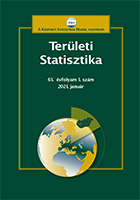A regionális megvalósult versenyképesség néhány szempontjának területi jellemzői Magyarországon 2010 és 2019 között
Spatial characteristics of some aspects of regional ‘realised
competitiveness’ in Hungary between 2010 and 2019
Author(s): György VidaSubject(s): Social Sciences, Economy, Geography, Regional studies
Published by: Központi Statisztikai Hivatal
Keywords: regional ‘realised competitiveness’; incomes; spatial patterns; spatial and social contexts
Summary/Abstract: In today's digitalising global economy, competition between regions and municipalities is increasingly intensifying across national borders. In addition, two events have occurred in recent decades that have had a major impact on the global economy. One was the global financial and economic crisis, the other the Covid-19 pandemic with its social and economic challenges. In the period between the-se shocks, the world experienced a relative economic recovery, but it can be seen that the competitiveness of the regions concerned and its analysis over time is important in the post-crisis recovery. This is no different in the United States, the European Union and,within that, Hungary. It can be concluded that regional ‘realised competitiveness’ between 2010 and 2019 in Hungary has shown a spatially different and distinctive geographical pattern that needs to be analysed. Therefore, the aim of the study is to examine the geographical pattern of regional ‘realised competitiveness’ and income divergence in Hungary between 2010 and 2019 and to shed light on some aspects and linkages. The author has formulated research questions to detect spatial and social processes and applied mathematical statistical and geoinformatics methods to answer them. The study concludes that there are significant spatial differences in the performance of areas and the income of their inhabitants, which were affected differently by various economic, spatial and social factors between 2010 and 2019.There is both a narrowing of spatial disparities and a widening of geographically differentiated income gaps in society. However, the changes that took place between 2010 and2019 are also reflected in the spatial pattern and context of the regional ‘ realised competitiveness’ of districts.
Journal: Területi Statisztika
- Issue Year: 62/2022
- Issue No: 05
- Page Range: 538-569
- Page Count: 32
- Language: Hungarian

